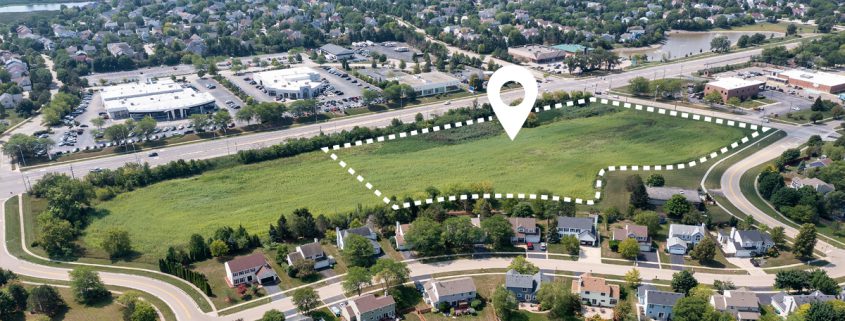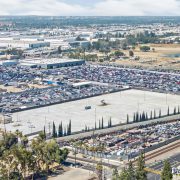Site Selection Demands Data-Driven Analysis and a Skilled Broker
Despite a slowdown in industrial construction due to a normalization of demand, slowing rental growth, elevated borrowing costs, and a flood of new building deliveries over the past several years, there is still a strong demand for developable sites.
That demand is fueled by the continued growth of e-commerce (expected to explode from about $6 trillion in sales at the end of 2024 to over $8 trillion by 2026 worldwide) and the explosion of manufacturing in the U.S. According to the Census Bureau, construction spending on new manufacturing facilities has nearly tripled in the last two years. The boom is a combination of two factors: The nearshoring and onshoring by U.S. manufacturers as they return operations stateside and to Mexico and the passage of the Infrastructure bill, CHIPS, and Inflation Reduction Acts, which are spurring investment in American manufacturing (as we noted in our Industrial Trends 2024 Part 1 and Part 2 posts earlier this year). One such local investment was by Chrysler and Jeep parent Stellantis, which announced last August that it would invest more than $100 million in Controlled Thermal Resources, the Imperial Valley company that uses breakthrough technology to produce lithium used in electric vehicle battery production.
Unfortunately for developers, suitable sites for ground-up development remain extremely limited and very expensive. The scarcity of land suitable for development — particularly for so-called “mega-sites” of over 1,000 acres or more — is not restricted to Southern California, as manufacturers of EV battery plants, semiconductor chips, and auto manufacturers can attest. The market for smaller sites is also challenging, so developers and companies seeking to locate their next manufacturing plant, distribution center, or e-commerce facility should undertake a multi-faceted analysis before selecting a site. And that’s why hiring a broker with a deep knowledge of the local market — armed with data analytics tools — is critical.
Combining Data Analysis with Market Knowledge in Site Selection

Let’s start with data analytics. Site selection software platforms use artificial intelligence, machine learning algorithms, and geographic information systems to provide a wealth of data for industrial real estate development projects. These include real-time analytics, market condition assessments, demographic information, traffic patterns, geographic details, and other relevant characteristics of the larger area being considered for the project that will help developers make informed decisions during the site selection process.
However, data without insights or experience can yield the wrong results. Successful brokers possess a deep understanding of their markets that goes far beyond the data. They can provide insights to help companies and developers navigate the site selection process — especially when it’s an industrial specialist. So combining the boots-on-the-ground knowledge and proprietary market intelligence a broker provides is a must.
What to Consider When Selecting a Site
Although the needs may differ for the various types of industrial assets — distribution centers, warehousing, and light and heavy manufacturing — the essential elements to selecting an industrial site include geographical location, availability of labor, skilled or unskilled, infrastructure, regulatory environment, and the municipal environment.

Location, Location, Location: This encompasses a number of areas, including access to major roads, railway access points, and, in some Southern California markets, ports. Proximity to suppliers and distribution outlets can also impact operational efficiency and cost-effectiveness. How employees travel to the job should also be a consideration. If the workforce is reliant on public transportation, is the site accessible? If employees drive, the site should have adequate space to accommodate parking for employee cars and trucks.

Infrastructure: While the federal and state governments are taking a long view and beginning programs to provide infrastructure for mega-sites, smaller-scale projects are often reliant on the existing infrastructure of the city or town. Developers should review the project’s communication, energy, water, and wastewater needs and determine what supply sources are readily available to the site. Engaging power companies and other utilities in the pre-selection process will help determine the cost and feasibility of the project.

Workforce Availability: Building the finest state-of-the-art manufacturing facility or distribution center won’t matter if there isn’t a sufficient labor force to staff it. With labor markets extremely tight right now, conducting a labor market analysis tailored to the facility’s needs is crucial to ensuring its long-term success. Does the facility require an unskilled or a highly trained workforce? What are the prevailing wages for skilled and unskilled workers in the region? Who are your competitors in the market for those workers? It is also worthwhile to consider proximity to educational institutions or training programs if specialized skills are required.

Environmental Issues: Developers should conduct due diligence for potential environmental concerns like soil contamination, flood risks, or whether the property is in a seismic zone or at risk for natural disasters such as wildfires. They should also be aware of potential remediation costs and regulatory compliance for the site.
Pros and Cons of a Municipality: Depending on the project and the anticipated benefit to the city or town, municipalities can be an ally or a foe. While some communities will offer loans, grants, expedited permitting, tax abatements, tax credits, and other incentives to attract companies, others can be less receptive to industrial development. There has been significant pushback from many communities when it comes to industrial development, often citing increased traffic and noise levels. Even in welcoming communities, regulations pertaining to building and fire codes and permitting and zoning must be carefully examined.

Explore Incentives: There are a number of government or economic development incentives that might offset costs for a development project. Research can often turn up surprising benefits.
This list is by no means complete, and what is meaningful will depend on the organization’s unique industry, business model, and long-term goals. In recent years, the site selection process has become as nuanced and complicated as ever, but it can yield favorable location solutions using the right tools. Consulting with experienced industrial specialists at Voit Real Estate Services can help you navigate the process and make an informed decision as you relocate or expand your business.









